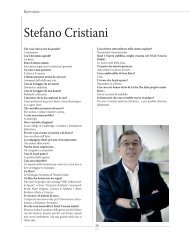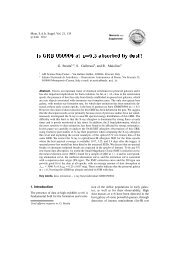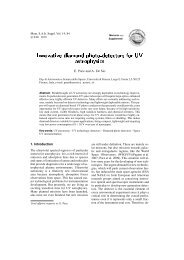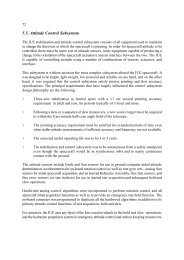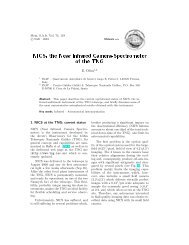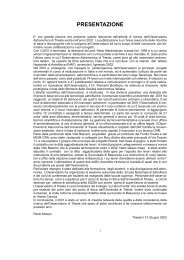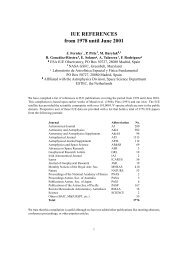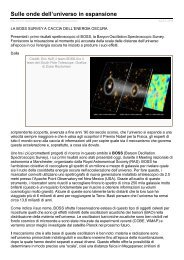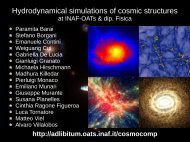Control system architecture for mid-infrared cameras: from TIRCAM2 ...
Control system architecture for mid-infrared cameras: from TIRCAM2 ...
Control system architecture for mid-infrared cameras: from TIRCAM2 ...
You also want an ePaper? Increase the reach of your titles
YUMPU automatically turns print PDFs into web optimized ePapers that Google loves.
60 L. Corcione et al.: <strong>TIRCAM2</strong><br />
The relevant <strong>system</strong> features are summarized<br />
in table 2.<br />
Overall, the acquisition <strong>system</strong> results<br />
in a multi-processor environment including<br />
nine DSPs, each executing optimized C algorithms<br />
<strong>for</strong> the specific tasks to be per<strong>for</strong>med:<br />
six DPSs are involved in capturing<br />
and pre-processing data, per<strong>for</strong>ming frame<br />
co-adding and statistic analysis; one DSP<br />
acts as a sequencer, producing the digital<br />
timings <strong>for</strong> the needs of the whole acquisition<br />
process, that is A-D conversion trigger,<br />
chopper control, filter wheel controls, and<br />
clocks <strong>for</strong> the array. Two other DSPs are<br />
available to per<strong>for</strong>m further on-line data<br />
analysis oriented, <strong>for</strong> instance, to guiding<br />
purpose or image reconstruction, i.e. shift<br />
and add.<br />
The camera software interface has been<br />
designed to meet the parallel hardware <strong>architecture</strong>.<br />
It consists of a multi-thread<br />
Windows like user interface, written by<br />
Visual C++ and executed in Win NT OS.<br />
The main thread handles the graphic interface<br />
and spawns ancillary threads which<br />
monitor the DSPs’ status, gather data <strong>from</strong><br />
DSPs and passe them to the main thread<br />
<strong>for</strong> further on line processing and display.<br />
The graphical user interface (GUI) is a collections<br />
of coordinating panels, which furnish<br />
user-friendly tools to set up the instrument.<br />
Different observing techniques are allowed:<br />
staring, beam-switching, chopping<br />
and chopping+nodding; all of the observing<br />
modes can be programmed and accomplished<br />
automatically. Each mode can be<br />
sorted in a sequence of equal integration<br />
cycle inclusive of periodic displays of the<br />
field being observed and data storing into<br />
file. Observing modes which require calibrated<br />
telescope movements, e.g. nodding<br />
and beam-switch, are supported by a dedicated<br />
interface to telescope pointing <strong>system</strong><br />
based on serial link RS232 compliant<br />
with the TIRGO standard message protocol.<br />
In real time, the program produces a<br />
quick look of the frames collected after preliminary<br />
pre-processing suited <strong>for</strong> the programmed<br />
observing mode. Data storing, in<br />
a standard FITS file, can take place both<br />
on the local disk and on a remote computer<br />
by the Ethernet link.<br />
3. The IRAIT <strong>mid</strong>-IR camera<br />
The IRAIT project (Tosti et al. 1997) is<br />
aimed at preparing a permanent observatory<br />
at Dome C, a site located at 3200<br />
height on the Antarctic plateau. To exploit<br />
the high-quality low-sky-background conditions<br />
offered by the site in spectral regions<br />
beyond 20µm, the Mid-IR camera of IRAIT<br />
is designed to operate with a Si:As detector<br />
array sensitivity in the range 5-28 µm, or a<br />
Si:Sb array <strong>for</strong> the extended range 5-40 µm.<br />
Antarctic environment requires robotic and<br />
remotely controlled operations <strong>for</strong> the telescope<br />
and its instrumentation and imposes<br />
accurate insulation <strong>for</strong> all the equipment<br />
not working in warm rooms. The telescope<br />
control <strong>system</strong> is under development<br />
and is designed as a distributed <strong>architecture</strong><br />
based on object oriented control<br />
software. Automatic operations are based<br />
on ad hoc script language, the Telescope<br />
<strong>Control</strong> Macro Language (TCML) (Tosti et<br />
al. 1995).<br />
The camera sub-<strong>system</strong>, sketched in figure<br />
1, complies with this standard. The detector<br />
is housed into a cryostat equipped<br />
with a closed cycle cooler suited <strong>for</strong> very<br />
low temperature (4-6 o K) cooling. So far,<br />
expertize in this field is available in countries<br />
outside Europe: leading firms providing<br />
well qualified cryogenic equipment are<br />
located in US or Japan. In order to promote<br />
European technology in this strategic<br />
field of low temperature <strong>system</strong>, Italian<br />
or Europen facilities will be invested with<br />
study and construction of the IRAIT camera<br />
cryostat.<br />
The controller is designed as split in two<br />
units. The front-end unit consists in a small<br />
PC rack configured as a PCI embedded <strong>system</strong>,<br />
which houses updated version of DSP<br />
based acquisition boards and the <strong>system</strong><br />
CPU <strong>for</strong> bus arbitration and <strong>system</strong> initialization.<br />
Custom pre-amplifiers and fully<br />
programmable bias-clock generator inter-



